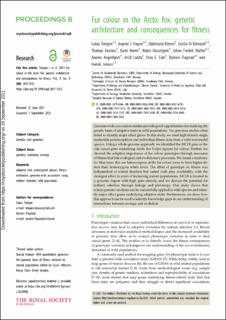| dc.contributor.author | Tietgen, Lukas | |
| dc.contributor.author | Hagen, Ingerid Julie | |
| dc.contributor.author | Kleven, Oddmund | |
| dc.contributor.author | Di Bernardi, Cecilia | |
| dc.contributor.author | Kvalnes, Thomas | |
| dc.contributor.author | Norén, Karin | |
| dc.contributor.author | Hasselgren, Malin | |
| dc.contributor.author | Wallen, Johan Fredrik | |
| dc.contributor.author | Angerbjörn, Anders | |
| dc.contributor.author | Landa, Arild | |
| dc.contributor.author | Eide, Nina Elisabeth | |
| dc.contributor.author | Flagstad, Øystein | |
| dc.contributor.author | Jensen, Henrik | |
| dc.date.accessioned | 2022-02-09T12:18:17Z | |
| dc.date.available | 2022-02-09T12:18:17Z | |
| dc.date.created | 2021-09-29T13:45:52Z | |
| dc.date.issued | 2021 | |
| dc.identifier.citation | Proceedings of the Royal Society of London. Biological Sciences. 2021, 288 . | en_US |
| dc.identifier.issn | 0962-8452 | |
| dc.identifier.uri | https://hdl.handle.net/11250/2977989 | |
| dc.description.abstract | Genome-wide association studies provide good opportunities for studying the genetic basis of adaptive traits in wild populations. Yet, previous studies often failed to identify major effect genes. In this study, we used high-density single nucleotide polymorphism and individual fitness data from a wild non-model species. Using a whole-genome approach, we identified the MC1R gene as the sole causal gene underlying Arctic fox Vulpes lagopus fur colour. Further, we showed the adaptive importance of fur colour genotypes through measures of fitness that link ecological and evolutionary processes. We found a tendency for blue foxes that are heterozygous at the fur colour locus to have higher fitness than homozygous white foxes. The effect of genotype on fitness was independent of winter duration but varied with prey availability, with the strongest effect in years of increasing rodent populations. MC1R is located in a genomic region with high gene density, and we discuss the potential for indirect selection through linkage and pleiotropy. Our study shows that whole-genome analyses can be successfully applied to wild species and identify major effect genes underlying adaptive traits. Furthermore, we show how this approach can be used to identify knowledge gaps in our understanding of interactions between ecology and evolution. | en_US |
| dc.language.iso | eng | en_US |
| dc.publisher | The Royal Society | en_US |
| dc.rights | Navngivelse 4.0 Internasjonal | * |
| dc.rights.uri | http://creativecommons.org/licenses/by/4.0/deed.no | * |
| dc.title | Fur colour in the Arctic fox: genetic architecture and consequences for fitness | en_US |
| dc.type | Journal article | en_US |
| dc.type | Peer reviewed | en_US |
| dc.description.version | publishedVersion | en_US |
| dc.source.pagenumber | 10 | en_US |
| dc.source.volume | 288 | en_US |
| dc.source.journal | Proceedings of the Royal Society of London. Biological Sciences | en_US |
| dc.identifier.doi | 10.1098/rspb.2021.1452 | |
| dc.identifier.cristin | 1940592 | |
| dc.relation.project | Norges forskningsråd: 223257 | en_US |
| dc.relation.project | Norges forskningsråd: 244557 | en_US |
| cristin.ispublished | true | |
| cristin.fulltext | original | |
| cristin.qualitycode | 2 | |

